Before English (Prehistory – c. 500AD)

Indo-European
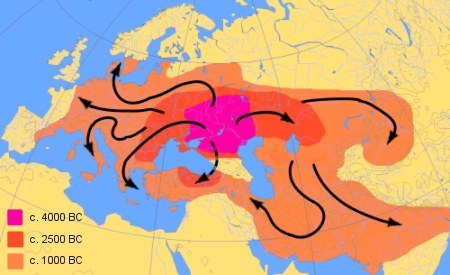
The English language, and indeed most European languages, traces it original roots back to a Neolithic (late Stone Age) people known as the Indo-Europeans or Proto-Indo-Europeans, who lived in Eastern Europe and Central Asia from some time after 5000 BC (different hypotheses suggest various different dates anywhere between the 7th and the 3rd millennium BC).
We do not know exactly what the original Indo-European language was like, as no writings exist from that time (the very earliest examples of writing can be traced to Sumeria in around 3000 BC), so our knowledge of it is necessarily based on conjecture, hypothesis and reconstruction. Using the “comparative method”, though, modern linguists have been able to partially reconstruct the original language from common elements in its daughter languages. It is thought by many scholars that modern Lithuanian may be the closest to (i.e. the least changed from) the ancient Indo-European language, and it is thought to retain many features of Proto-Indo-European now lost in other Indo-European languages.
Indo-European is just one of the language families, or proto-languages, from which the world’s modern languages are descended, and there are many other families including Sino-Tibetan, North Caucasian, Afro-Asiatic, Altaic, Niger-Congo, Dravidian, Uralic, Amerindian, etc. However, it is by far the largest family, accounting for the languages of almost half of the modern world’s population, including those of most of Europe, North and South America, Australasia, the Iranian plateau and much of South Asia. Within Europe, only Basque, Finnish, Estonian, Hungarian, Turkish, and a few of the smaller Russian languages are not descended from the Indo-European family.
Spread of Indo-European Languages
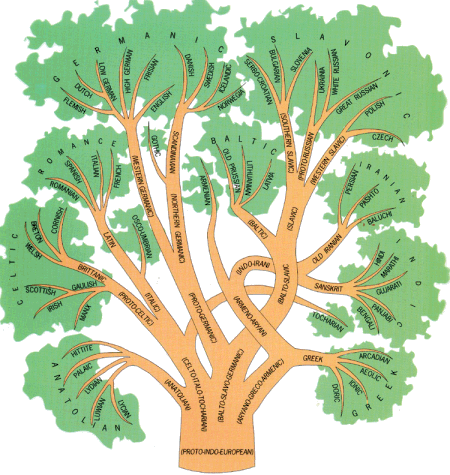
Sometime between 3500 BC and 2500 BC, the Indo-Europeans began to fan out across Europe and Asia, in search of new pastures and hunting grounds, and their languages developed – and diverged – in isolation. By around 1000 BC, the original Indo-European language had split into a dozen or more major language groups or families, the main groups being:
- Hellenic
- Italic
- Indo-Iranian
- Celtic
- Germanic
- Armenian
- Balto-Slavic
- Albanian
In addition, several more groups (including Anatolian, Tocharian, Phrygian, Thracian, Illyrian, etc) have since died out completely, and yet others may have existed which have not even left a trace.
These broad language groups in turn divided over time into scores of new languages, from Swedish to Portuguese to Hindi to Latin to Frisian. So, it is astounding but true that languages as diverse as Gaelic, Greek, Farsi and Sinhalese all ultimately derive from the same origin. The common ancestry of these diverse languages can sometimes be seen quite clearly in the existence of cognates (similar words in different languages), and the recognition of this common ancestry of Indo-European languages is usually attributed to the amateur linguist Sir William Jones in 1786. Examples are:
- father in English, Vater in German, pater in Latin and Greek, fadir in Old Norse and pitr in ancient Vedic Sanskrit.
- brother in English, broeer in Dutch, Brüder in German, braithair in Gaelic, bróðr in Old Norse and bhratar in Sanskrit.
- three in English, tres in Latin, tris in Greek, drei in German, drie in Dutch, trí in Sanskrit.
- is in English, is in Dutch, est in Latin, esti in Greek, ist in Gothic, asti in Sanskrit.
- me in English, mich or mir in German, mij in Dutch, mik or mis in Gothic, me in Latin, eme in Greek, mam in Sanskrit.
- mouse in English, Maus in German, muis in Dutch, mus in Latin, mus in Sanskrit.
Germanic
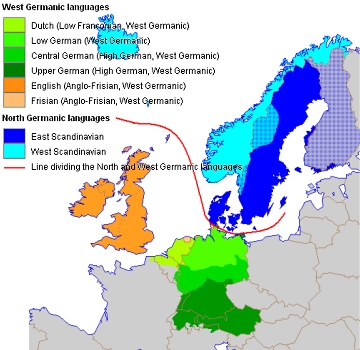
The branch of Indo-European we are most interested in is Germanic (although the Hellenic-Greek branch and Italic-Latin branch, which gave rise to the Romance languages, also became important later). The Germanic, or Proto-Germanic, language group can be traced back to the region between the Elbe river in modern Germany and southern Sweden some 3,000 years ago.
Jacob Grimm (of fairy tales fame, but also a well-respected early philologist) pointed out that, over time, certain consonants in the Germanic family of languages have shifted somewhat from the Indo-European base. Thus, Germanic words like the English foot, West Frisian foet, Danish fod, Swedish fot, etc, are in fact related to the Latin ped, Lithuanian peda, Sanskrit pada, etc, due to the shifting of the “p” to “f” and the “d” to “t”. Several other consonants have also shifted (“d” to “t”, “k” to “h”, “t” to “th”, etc), disguising to some extent the common ancestry of many of the daughter languages of Indo-European. This process explains many apparent root differences in English words of Germanic and Latinate origin (e.g. father and paternal, ten and decimal, horn and cornucopia, three and triple, etc).
The early Germanic languages themselves borrowed some words from the aboriginal (non-Indo-European) tribes which preceded them, particularly words for the natural environment (e.g. sea, land, strand, seal, herring); for technologies connected with sea travel (e.g. ship, keel, sail, oar); for new social practices (e.g. wife, bride, groom); and for farming or animal husbandry practices (e.g. oats, mare, ram, lamb, sheep, kid, bitch, hound, dung).
The Germanic group itself also split over time as the people migrated into other parts of continental Europe:
- North Germanic, which evolved into Old Norse and then into the various Scandinavian languages, Swedish, Danish, Norwegian and Icelandic (but not Finnish or Estonian, which are Uralic and not Indo-European languages);
- East Germanic, spoken by peoples who migrated back to eastern and southeastern Europe, and whose three component language branches, Burgundian, Vandalic and Gothic (a language spoken throughout much of eastern, central and western Europe early in the first millennium AD), all died out over time; and
- West Germanic, the ancestor of Old High German, Old Saxon, Old Frisian, Old Low Franconian and others which in turn gave rise to modern German, Dutch, Flemish, Low German, Frisian, Yiddish and, ultimately, English.
Thus, we can say that English belongs to the West Germanic branch of the Indo-European family of languages.
The Celts
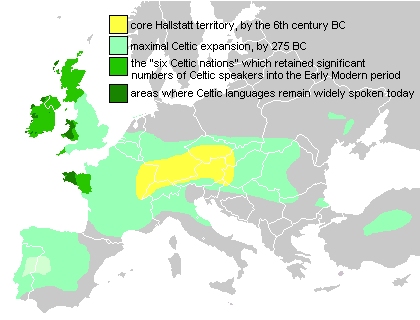
Little or nothing is known about the original hunter-gatherer inhabitants of the British Isles before they were cut off from the rest of Europe by the English Channel (around 5000-6000 BC). Indeed, little is know of the so-called Beaker People and others who moved into the British Isles from Europe around 2500 BC, and were probably responsible for monuments like Stonehenge around this time.
The earliest inhabitants of Britain about which anything is known are the Celts (the name from the Greek keltoi meaning “barbarian”), also known as Britons, who probably started to move into the area sometime after 800 BC. By around 300 BC, the Celts had become the most widespread branch of Indo-Europeans in Iron Age Europe, inhabiting much of modern-day Spain, Italy, France, Germany, Austria, the Balkans, Eastern Europe and also Britain.
Parts of Scotland were also inhabited from an early time by the Picts, whose Pictish language was completely separate from Celtic and probably not an Indo-European language at all. The Pictish language and culture was completely wiped out during the Viking raids of the 9th Century AD, and the remaining Picts merged with the Scots. Further waves of Celtic immigration into Britain, particularly between 500 BC and 400 BC but continuing at least until the Roman occupation, greatly increased the Celtic population in Britain, and established a vibrant Celtic culture throughout the land.
But the Celts themselves were later marginalized and displaced, as we will see in the next section, and Celtic was not the basis for what is now the English language. Despite their dominance in Britain at an early formative stage of its development, the Celts have actually had very little impact on the English language, leaving only a few little-used words such as brock (an old word for a badger), and a handful of geographical terms like coombe (a word for a valley) and crag and tor (both words for a rocky peak). Having said that, many British place names have Celtic origins, including Kent, York, London, Dover, Thames, Avon, Trent, Severn, Cornwall and many more. There is some speculation that Celtic had some influence over the grammatical development of English, though, such as the use of the continuous tense (e.g. “is walking” rather than “walks”), which is not used in other Germanic languages. The Celtic language survives today only in the Gaelic languages of Scotland and Ireland, the Welsh of Wales, and the Breton language of Brittany.
The Romans
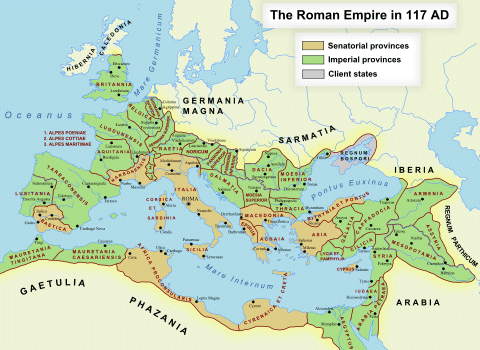
The Romans first entered Britain in 55 BC under Julius Caesar, although they did not begin a permanent occupation until 43 AD, when Emperor Claudius sent a much better prepared force to subjugate the fierce British Celts. Despite a series of uprisings by the natives (including that of Queen Boudicca, or Boadicea in 61 AD), Britain remained part of the Roman Empire for almost 400 years, and there was a substantial amount of interbreeding between the two peoples, although the Romans never succeeded in penetrating into the mountainous regions of Wales and Scotland.
Although this first invasion had a profound effect on the culture, religion, geography, architecture and social behaviour of Britain, the linguistic legacy of the Romans’ time in Britain was, like that of the Celts, surprisingly limited. This legacy takes the form of less than 200 “loanwords” coined by Roman merchants and soldiers, such as win (wine), butere (butter), caese (cheese), piper (pepper), candel (candle), cetel (kettle), disc (dish), cycene (kitchen), ancor (anchor), belt (belt), sacc (sack), catte (cat), plante (plant), rosa (rose), cest (chest), pund (pound), munt (mountain), straet (street), wic (village), mil (mile), port (harbour), weall (wall), etc. However, Latin would, at a later time (see the sections on The Coming of Christianity and Literacy and The English Renaissance), come to have a substantial influence on the language.
Latin did not replace the Celtic language in Britain as it had done in Gaul, and the use of Latin by native Britons during the peiod of Roman rule was probably confined to members of the upper classes and the inhabitants of the cities and towns. The Romans, under attack at home from Visigoths, Ostrogoths and Vandals, abandoned Britain to the Celts in 410 AD, completing their withdrawal by 436 AD. Within a remarkably short time after this withdrawal, the Roman influence on Britain, in language as in many other walks of life, was all but lost, as Britain settled in to the so-called Dark Ages.